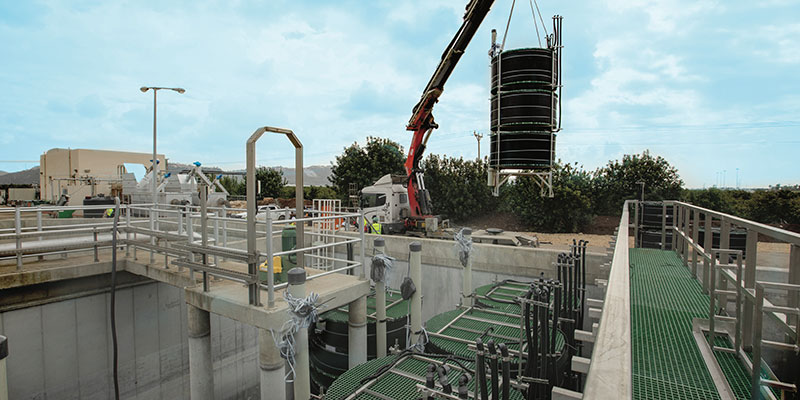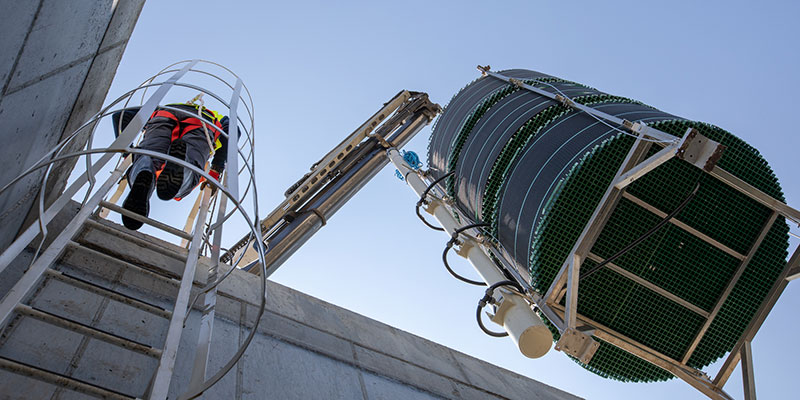
Fluence’s MABR product line includes SUBRE, which uses towers of MABR units to retrofit existing wastewater treatment plants, increasing capacity and nutrient removal.
MABR wastewater treatment modules provide effluent that’s suitable for reuse, while reducing energy and chemical needs
Membrane aerated biofilm reactor (MABR) technology provides a revolutionary improvement in aerobic wastewater treatment. In particular, it has high nutrient removal and energy efficiency, compared to traditional wastewater treatment systems.
At the heart of Fluence’s MABR, there is a self-respiring, spirally wound membrane envelope that passively delivers oxygen directly into the wastewater so that helpful bacteria can grow. An aerobic bacterial biofilm forms on the large surface area of the oxygen-rich membrane, while anaerobic bacteria flourish in the anoxic environment of the rest of tank.
This setup allows for simultaneous nitrification-denitrification (SND) in a single tank, a process that once required multiple chambers. This consolidation allows the treatment plant to be more space-efficient, while producing a high-quality effluent suitable for reuse in irrigation, dust reduction, toilet flushing, and other nonpotable reuse applications.
Legacy aerobic treatment tends to consume a lot of energy due to traditional wastewater aeration, which uses blowers, mechanical aerators, or other mechanisms to introduce bubbles into wastewater. In this inefficient process, most of the bubbles quickly rise to the surface before microorganisms can use them.
In a major technological breakthrough, MABR systems cut aeration energy use by up to 90%, and overall energy use by as much as 50%. Instead of actively pumping bubbles, with MABR the air passes through the membrane passively. This passive aeration of the mixed liquor takes place at near-atmospheric pressure. Periodically, some air is used for mixing.
Learn more about how MABR works in this short technical video:
Decentralized Treatment with MABR
MABR has distinct advantages over legacy processes for decentralized wastewater treatment. The small-footprint, single-tank design of MABR modules allows containerized packaging for easy shipping. Bringing treatment to the point of need leads to high CAPEX savings on pipeline and pumping station construction, as well OPEX savings on the energy used to operate them.
Fluence’s Smart Packaged Aspiral™ wastewater treatment plants, shown in the video below, are furnished in standard shipping containers to provide unparalleled agility for changing requirements — such as when a work camp moves to a new oilfield — and quick response to emergency needs, for instance, after natural disasters.
Plug-and-play Aspiral™ units are built into weatherized, storm- and corrosion-resistant steel shipping containers. Multiple plants can work in tandem, and capacity can be scaled up or down by simply adding or removing units, which then can be redeployed or sold if needs change.
MABR in Action
In the case of wastewater treatment, MABR’s value in a decentralized strategy is well illustrated by a major Aspiral™ project underway in Central China. Along a major highway in the Hubei Province, 80 Aspiral™ MABR units are being installed at rest areas every 50 km. China’s Five-Year Plan mandates fast action on its targets, and Aspiral™ is designed to deliver Chinese Class 1A-compliant treatment at unrivaled speed. In another example in Henan Province, Taiping — a remote, hard-to-access village of 5,000 inhabitants — a 300 m³/d Aspiral™ plant was installed and commissioned within a 10-day window.
MABR’s low-odor, low-noise operation makes it neighborhood-friendly for industrial parks, urban settings, rural schools, and remote workforce housing camps. For instance, at a worker camp in Carlsbad, New Mexico, a Fluence Aspiral™ MABR installation turned a regulatory crackdown into praise from local regulators. The camp’s operator was able to remove the burden of wastewater treatment from local infrastructure and reuse the effluent for dust control.
Because of Aspiral™’s small footprint, the plants are easily concealed, making them ideal for tourist areas and beach resorts.
Aspiral™ also is climate-change resilient due to its low energy needs. In the aftermath of Hurricane Irma on St. Thomas, the U.S. Virgin Islands, an MABR treatment plant serving the community of Bordeaux was able to re-establish service with a generator long before the island’s large-scale infrastructure was able to come back online. During the 2020 global COVID pandemic, an Aspiral™ S1 demonstration system in the CENTA research center, Spain, was left unattended for nearly two months. It continued to operate successfully, providing excellent treatment results.
MABR Installation Options

To increase capacity and enhance effluent quality, towers of SUBRE modules can be submerged in the basins of existing wastewater treatment plants.
Flexibility is a major MABR benefit. In addition to Smart Packaged Aspiral™ plants, MABR can also be used to upgrade existing centralized treatment plants. In cases where existing wastewater treatment plants can no longer meet required capacity or effluent standards — for instance, due to increased urbanization — it’s no longer necessary to build a new plant to meet needs.
Fluence’s SUBRE option uses submerged towers of MABR modules to retrofit existing plants. SUBRE is designed to upgrade existing basins with capacities of 2,000-100,000 m3/d (0.5-25 MGD), improving nutrient removal without the addition of organic chemicals like methanol.
SUBRE also is an option for new projects, like the three-plant, 15,100 m³/d SUBRE project at the Port of Sihanoukville in Cambodia.
Learn more about SUBRE in this short video:
Putting MABR to the Test
In the spring of 2019, Andalusian Public Foundation Center for New Water Technologies (CENTA) in Spain began a yearlong test of an Aspiral™ S1 unit under a wide range of climate conditions and with a variety of effluents. After the plant passed its startup phase, in its exploitation phase it recorded total nitrogen levels (TN) as low as 4.1 mg/L, and total phosphorus (TP) was as low as 0.4 mg/L.
In the U.S., Fluence MABR passed a yearlong pilot test at Stanford University’s Codiga Resource Recovery Center (CR2C) in California, with effluent meeting the state’s strict Title 22 standards for reuse. The Fluence MABR pilot units were shown to reduce levels of nutrients to (TN) <3 mg/L and (TP) <0.3 mg/L.
The Growing Market for MABR
This success at Stanford marks Fluence MABR’s market entry into California, which has the world’s fifth largest economy. Frequent drought conditions there have led to the overpumping of aquifers, particularly in agricultural regions like the Central Valley. Fluence Aspiral™ units have the potential to preserve groundwater reserves by converting wastewater into a water source for agricultural irrigation.
Commercial use of MABR began only in 2016, but expansion of MABR has exceeded original expectations. Fluence, which has established core operations in the Americas, Europe, the Mideast, and China, has made significant inroads in the global market with MABR. With strategic partnerships covering more than 70% of China, Fluence is already fulfilling orders in Henan, Guizhou, and Hubei.
Fluence’s MABR solutions can meet a wide range of wastewater treatment needs efficiently and sustainably. Contact Fluence to learn more about MABR technology and how it can save energy while producing high-quality effluent.
